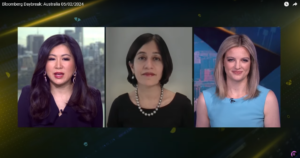“Markets are moved by a mix of rational calculus and human behavior.”
– Royal Swedish Academy of Sciences in its 2013 Nobel Memorial Prize Economics Award
Equity markets are always evolving. A change in the mix of market participants, a change in the behavior of market participants or regulatory changes resetting ‘rational calculus’ can all result in market evolution. Chinese equities are witnessing all of the above.
The mix of market participants is changing with an increase in participation from global investors, passive investors, quantitative investors and short sellers. The behavior of market participants is changing as domestic institutional investors become more sophisticated. Simultaneously, changes in regulation, disclosures and technology are also impacting equity markets.
As a result of these and more changes, many of the traditional factors that predicted stock returns in the past may not necessarily predict returns to the same extent in the future. In this note, we discuss the efficacy of the size premium in Chinese (onshore) equities.The size premium is the historical tendency for stocks of firms with smaller market capitalizations to outperform stocks of firms with larger market capitalizations. In most equity markets across the world, the size premium is not significant or consistent. A pure factor portfolio betting on the size premium (a frictionless long/short portfolio that goes long small stocks and shorts large stocks while simultaneously minimizing all other sources of risk) has not generated a significant Sharpe ratio over the last 10 years in most markets. However, until recently China has been different and small cap stocks have significantly outperformed large cap stocks in China. Specifically, small cap stocks have outperformed large cap stocks by over 10% on annualized basis from Jan 2005 – Apr 2016, more than a 10 year period. This trend has reversed recently and over the last three years, small cap stocks have under-performed large cap stocks by over 19% annualized.
1. The FTSE China A 50 Index is used as a proxy for Large Cap stocks. This Index includes the largest 50 A-Share Chinese companies by total market cap. The CSI 500 Net Total Return Index is used as a proxy for Small Cap stocks. CSI 500 Index consists of the largest remaining 500 A-Share stocks after excluding both the CSI 300 Index constituents and the largest 300 stocks. The Index reflects the overall performance of small-mid cap A-shares. All Returns are in USD.
Why did small cap stocks outperform so strongly historically? What explains the recent performance? What is our expectation going forward?
Researchers studying U.S. stocks have shown that the size premium is subsumed by other proxies like beta or diluted by the junk like characteristics of small stocks. We believe there is a distinct and more important effect explaining the size premium in China.
A significant part of the size premium in China can be explained by IPO constraints and the resulting reverse mergers. The IPO process in China is heavily regulated and arduous. The total number of firms allowed to IPO in a given time period is tightly controlled by government policy and there is often a backlog of firms waiting to IPO2. In such a setting, any listed entity has a “shell value” (irrespective of its fundamental value) simply because it is a listed entity. Private companies that are unable to obtain approvals to list often acquire small listed companies with the primary purpose of acquiring a listing. As a result, small companies with poor businesses and weak management, are still valuable and this shell value gets realized when they get acquired3,4. This explains a substantial part of the size premium in China.
As financial sector reform continues, this shell value is likely to decline. The authorities recently announced the formation of a Science-Technology Innovation Board that will allow pre-revenue/earnings companies to IPO on the exchange. This board will also remove other restrictions like valuation limits on IPO pricing and first day gains. More importantly, listings will only require “registration” not “approval.” This Board seems to be gaining traction5 with the first batch of IPO’s expected in 2019.
As this board comes on line and listing processes become easier, we believe less companies will be looking for potential shell targets. In our opinion, Shell Values are likely to decline and small cap stocks which are unprofitable are more likely to underperform rather than trade exclusively on their Shell Value, thus lowering the size premium.
It can be argued that another reason for the size premium to exist is the preference of Chinese domestic retail investors to buy small cap, risky, lottery like stocks. This behavior is unlikely to change. However, we observe that domestic institutions which historically traded like retail investors are becoming more sophisticated and the influx of foreign capital is increasing as well. While there may be periods of small cap outperformance, we believe that it’s unlikely that the size premium will have the same payoff in future as it has had in the past.
This is only one aspect of how China’s equity market is evolving. Watch this space for our views of other aspects of China’s evolution.
2. For example, as of the end of October 2016, companies meeting China’s pre-specified listing standards (including total revenue and profitability thresholds) and awaiting CSRC processing numbered 806. Between 2014 and 2017, the average wait time in this queue is 24.5 months historical wait times prior to 2014 are likely longer. Source: Lee, Qu and Shen 2018: “Gate Fees: Shell Values and Regulatory Risk in Chinese Equity Markets”
3. This is typically called a reverse merger, with the private company’s ownership team ultimately taking over control of the combined publicly traded entity.
4. Lee (2018), et al. document that during 2007-2015 unlisted Chinese firms paid an average of over $400M for each listed shell entity, an amount exceeding 2/3 of the median market capitalization of listed firms. In fact, 83% of the reverse mergers in China involve shells coming from the smallest 30% of stocks. Researchers document that for a typical stock in the bottom 30% of size rankings, approximately 40% of its market value reflects its potential shell value in a reverse merger. Further, there is evidence to show that prices of small stocks in China are less driven by fundamentals.
5. A report by Goldman Sachs called the Science-Technology Innovation Board a “Chinese Nasdaq” in the making and estimated “as much as $2T of potential market cap.”
Disclaimer:
While many of the thoughts expressed in the attached materials are stated in a factual manner, the discussion reflects only Nipun’s beliefs about these investments and the related markets. These materials may contain forward-looking statements based on Nipun’s expectations and projections about these investments. Those statements are sometimes indicated by words such as “expects,” “believes,” “will” and similar expressions. In addition, any statements that refer to expectations, projections or characterizations of future events or circumstances, including any underlying assumptions, are forward-looking statements. Such statements are not guaranties of future performance and are subject to certain risks, uncertainties and assumptions that are difficult to predict. Therefore, actual returns could differ materially and adversely from those expressed or implied in any forward-looking statements as a result of various factors. The attached information was prepared as of the date hereof, and may be different as of the date you review it. Nipun and its affiliates undertake no obligation to revise or update any statement in these materials for any reason.






